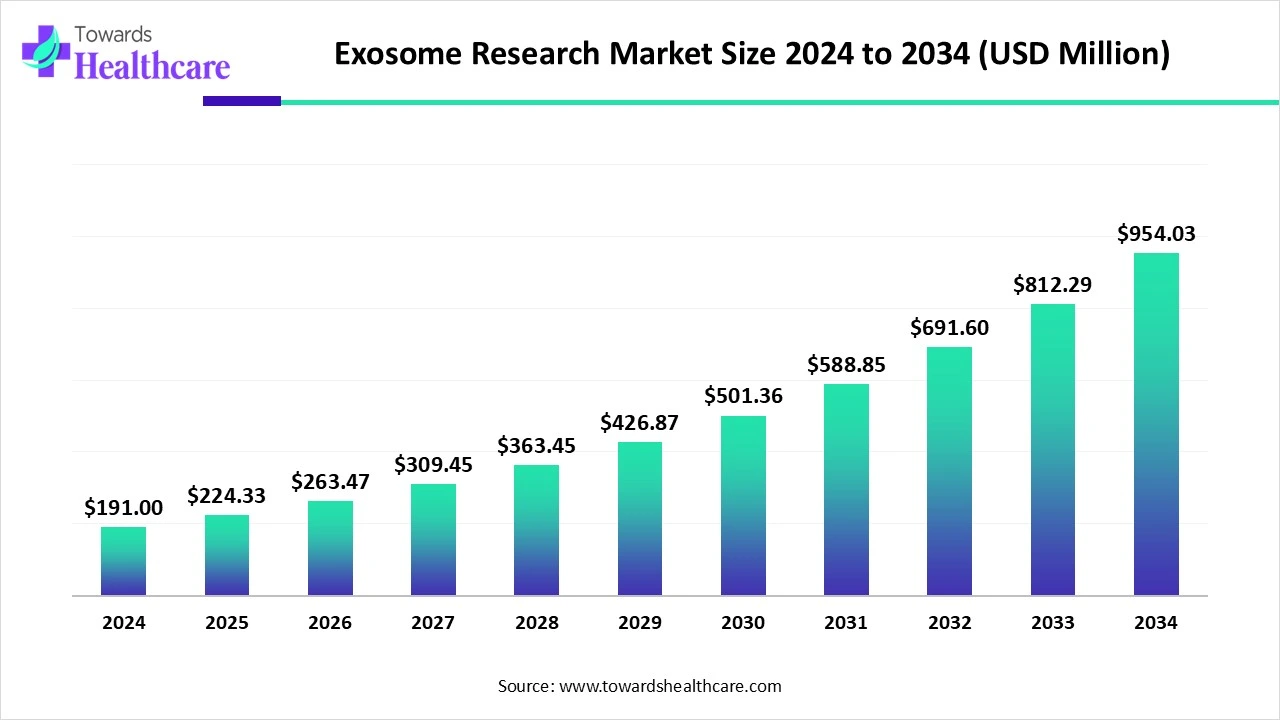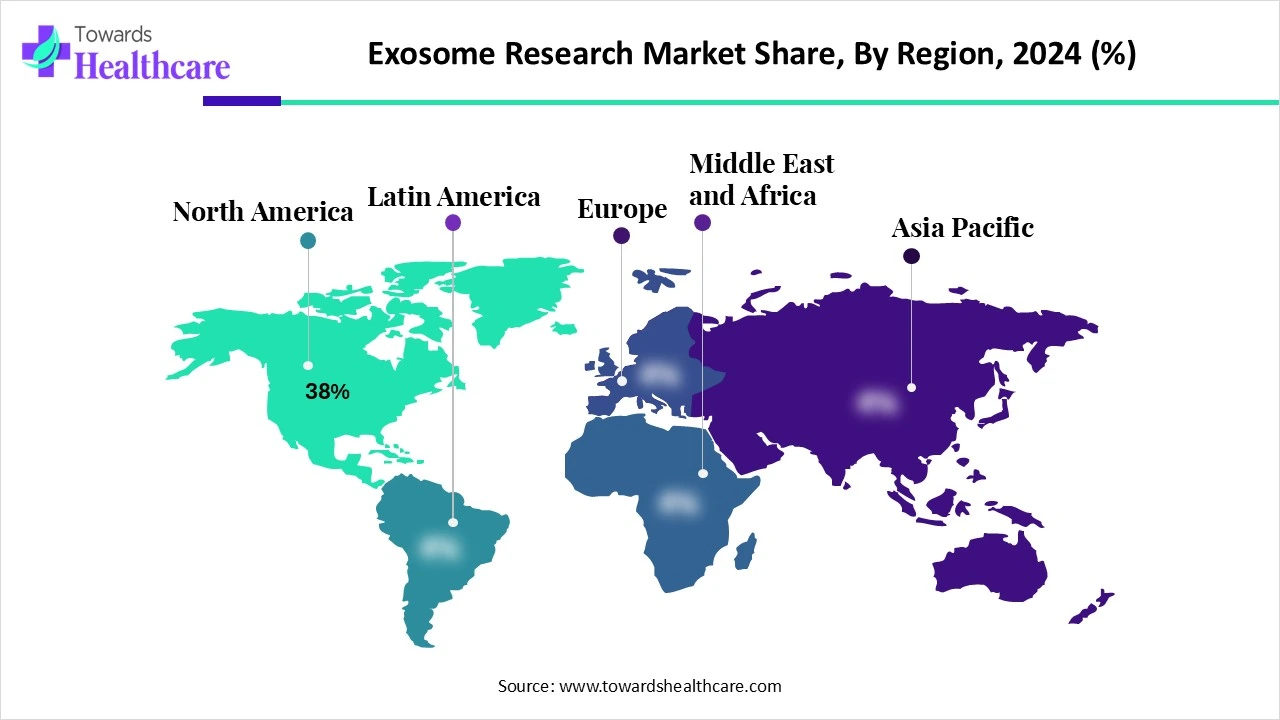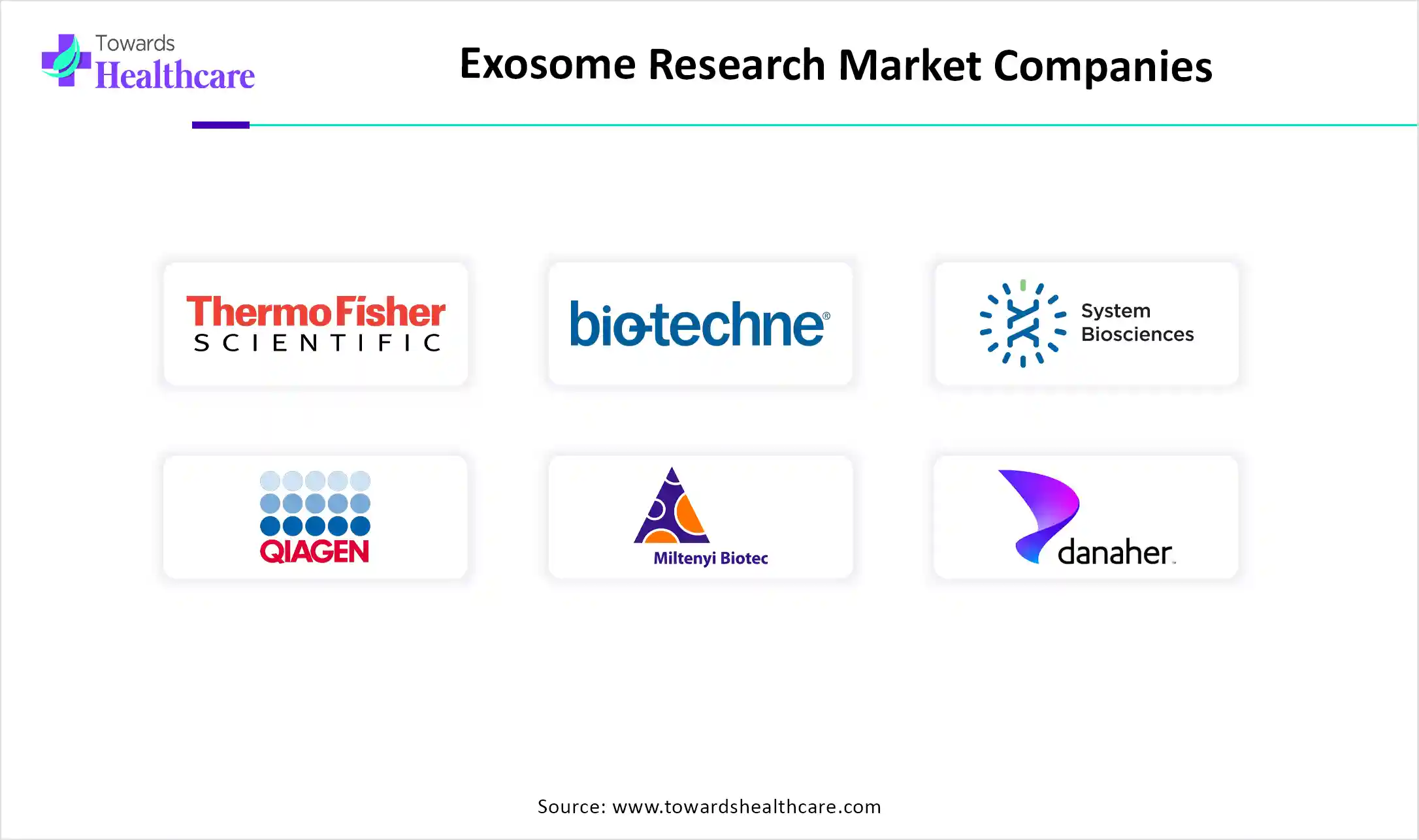December 2025

The global exosome research market size recorded US$ 191 million in 2024, set to grow to US$ 224.33 million in 2025 and projected to hit nearly US$ 954.03 million by 2034, with a CAGR of 17.45% throughout the forecast timeline.

Nowadays, exosomes, called extracellular vesicles, are widely used in the development of novel therapeutic agents, precision medicine, and biomarkers. Along with this, rising technological breakthroughs in the exosome research market, such as magnetic beads or microfluidic devices and NTA, Western blot, and ELISA, are boosting the adoption of exosomes in ongoing research. Moreover, many regions like China and Japan are accelerating the use of plant-based and chemical-derived exosomes in skin care, cancer, and neurological diseases. Also, putting efforts into the progress of liquid biopsy is driving the complete market development with its enhanced adoption.
| Table | Scope |
| Market Size in 2025 | USD 224.33 Million |
| Projected Market Size in 2034 | USD 954.03 Million |
| CAGR (2025 - 2034) | 17.45% |
| Leading Region | North America Share 38% |
| Market Segmentation | By Product Type, By Application, By Workflow, By End User, By Region |
| Top Key Players | Thermo Fisher Scientific, Bio-Techne Corporation, System Biosciences (SBI), QIAGEN, NanoView Biosciences, Miltenyi Biotec, Danaher Corporation, Exosome Diagnostics, Lonza, Norgen Biotek Corp, Malvern Panalytical, NanoFCM, Creative Biolabs, AMS Biotechnology, Evox Therapeutics, HansaBioMed Life Sciences, Diagenode, Exosomics, Aruna Bio |
The exosome research market focuses on tools, platforms, and services used for the isolation, characterization, quantification, and functional analysis of exosomes, small extracellular vesicles secreted by cells. These vesicles are gaining importance for their potential role as biomarkers in cancer diagnostics, neurological disease tracking, and therapeutic delivery systems. The market includes reagents, instruments, software, kits, and services used across academic research, clinical diagnostics, and drug development. Increasing interest in liquid biopsy and personalized medicine has driven market growth.
Heavy investments in pharmaceutical and life sciences research and advances in exosome-based diagnostic and therapeutic applications are boosting the respective market expansion.
AI has a crucial role in various markets, due to its versatility and increased work efficiency. In this respective market, AI is widely used in the analysis of complex exosome datasets, which further assist in biomarker identification and establish novel predictive models for disease diagnosis and treatment. ChatExosome is an example of an AI-powered platform that escalates the diagnosis of hepatocellular carcinoma (HCC). Moreover, different exome-based diagnostics coupled with AI, as well as the adoption of AI in exome research kits and reagents, are helping to boost the effectiveness and accuracy of exosome isolation and analysis processes.
A Surge in Technological Breakthroughs and Pharmaceutical R&D
In the world, the global exosome research market is experiencing major expansion is fueled by ongoing technological developments in exosome isolation and analysis, such as the application of magnetic beads or microfluidic devices and NTA, Western blot, and ELISA, respectively. Other omics technologies like proteomics, genomics, and lipidomics are offering a detailed understanding of the molecular composition of exosomes. Moreover, the market has another driver called tremendous investments in exosome research and development, mainly in drug delivery and diagnostics.
Large-Scale Production and Cargo Loading Concerns
Primarily, expanding the production of exosomes from laboratory research to a commercial level creates a vital challenge in the global exosome research market. As it requires ultracentrifugation and ensuring consistency in properties during scale-up is one of the major limitations. Also, as exosomes carry numerous molecules, the mechanisms of cargo loading and release are another developing restraint in the market.
Enhanced Focus on Services and Other Ongoing Research
During 2025-2034, exosomes will present several opportunities in the expanding market, particularly in specialized services. In this area, the adoption of specialized service providers will allow end-to-end solutions coupling isolation technologies with advanced molecular description and data analytics, which will accelerate the demand for outsourced exosome research and development support. Besides this, the global exosome research market encompasses novel research activities, such as the detection of exosomes derived from adipose-derived stem cells (ADSCs), which are applied in wound healing. Additionally, in cases of Alzheimer's and Parkinson's, exosomes will play a crucial role in regulating neuroinflammation, promoting neurogenesis, and serving as potential biomarkers and therapeutic targets.
In 2024, the reagents & kits segment captured the largest share of the exosome research market. Due to the increasing need for these reagents and kits in streamlining exosome isolation, identification, scalability, and characterization in biomarker discovery and liquid biopsy research. ExoQuick-TC is a polymer-derived reagent that is widely employed in exosome isolation from cell culture media. Whereas, EV Isolation Kit Pan, human is a kit which is based on MACS Technology, by using MicroBeads applied in case of cell culture supernatant, plasma, urine, or ascites.
However, the RNA/DNA extraction kits segment is predicted to expand at a rapid CAGR. This type of product possesses widespread advantages over the others, such as broad usage in the extraction of high-quality RNA and DNA from purified exosomes, which are found in blood, urine, and cell culture media. In RNA and DNA isolation, Norgen Biotek Corp., ExoBrite EV Total RNA Isolation Kit, and Creative Bioarray are employed as per requirement in RNA and DNA.
By application, the cancer research segment dominated the market in 2024. Exosomes have a major role in enabling cancer cell communication, with enhanced incorporation in tumor progression, metastasis, and drug resistance. In addition, exosomes can also impact the tumor microenvironment, promising contribution in angiogenesis (new blood vessel formation) and modulating immune responses. Mainly, advancements in life sciences, such as nanotechnology and molecular biology, are driving the need for novel tools and techniques for exosome research.
Moreover, the drug delivery systems segment is anticipated to register the fastest growth. Basic benefits of exosomes, like their biocompatibility, biodegradability, and penetration via biological carriers, are propelling the development of drug delivery systems. Different loading techniques are used, such as passive loading (incubation), active loading, and genetic engineering. Alongside, the adoption of exosome-based approaches resolves restrictions of conventional drug delivery systems, including lower bioavailability, off-target effects, and immune system disruption.
By workflow, the isolation segment led the global exosome research market in 2024. The growing utilization of exosomes in diverse research areas, particularly in cancer biology, cardiovascular research, immunology, and neurodegenerative disease studies, is driving the adoption of an isolation workflow. Whereas, commonly used isolation approaches are ultracentrifugation, size-exclusion chromatography (SEC), and immunoaffinity capture, which are significant for studying exosome biogenesis, function, and their potential as biomarkers or drug delivery vehicles.
The microfluidics-based isolation segment will grow rapidly in the coming era. In exosome research activities, this kind of isolation uses small sample volumes, leading to greater isolation rates. Moreover, they comprise isolation of highly pure exosomes with reduced contamination from other cellular debris and vesicles. Other advantages, like the versatility, such as by using microfluidic devices, they can customize size, density, and surface markers, using methods like size-exclusion, dielectrophoresis, or immunoaffinity, are increasingly fueling overall segments’ and market expansion.
In 2024, the academic & research institutes segment held the biggest revenue share of the market. Across the globe, the segment is driven by growing fundamental research activities in different universities and research institutions, including describing exosome function and role in a variety of biological processes. Apart from this, the NIH fosters and funding in numerous exosome research projects, resulting in a global understanding of exosomes. Besides this, wide-range participation of universities and research institutions in exosome research with enhanced emphasis on cancer, immunology, and drug delivery.
On the other hand, the pharmaceutical & biotechnology companies segment is estimated to grow at the fastest CAGR during 2025-2034. As the rising focus on the development of novel drug delivery by using small molecules, RNA, and proteins, to specific cells and tissues, ultimately optimizing drug efficacy and less the chances of off-target effects, is impacting these companies' development. Also, the accelerating demand for regenerative medicine and other therapeutics used in cancer and inflammatory conditions is boosting the adoption of exosomes in pharmaceutical and biotechnology companies.

By accounting for a major revenue share by 38% in 2024, North America led the market. The market is propelled by advanced research infrastructure, as well as the presence of various academic institutions and biotechnology companies which are emerged in exosome research. Moreover, ongoing technological innovations in exosome isolation approaches, characterization, and analysis techniques, like micro-nanotechnologies, are further fueling the market growth. Also, this region is emphasizing the progress of isolation approaches, translating research findings into clinical applications (diagnostics and therapeutics).
Due to a robust healthcare system, continuous collaboration among strong and well-developed companies in the U.S. is driving the overall market growth. As well as the U.S. is also aiming at the adoption of micro-nanotechnologies for extracellular vesicle applications, particularly in immuno-oncology.
For instance,
In Canada, the growing application of exosomes in chronic conditions, including heart diseases, neurodegenerative conditions, and other concerns, is boosting the respective market progress. Also, the Canadian government initiatives are actively encouraging regenerative medicine and diagnostics, which further expand the market.
For this market,
During 2025-2034, in the global exosome research market, the Asia Pacific will expand fastest. Eventually, enhanced focus on oncology, neurodegenerative disorders, and diagnostics, accelerating investments in R&D. Furthermore, China, Japan, South Korea, and India are stepping into the expansion of biopharmaceutical infrastructure and other facilities required in exosome research activities. Besides this, ASAP is also seeking advancements in exosome isolation techniques, with an emphasis on miniaturization and high-throughput platforms.
In the Japanese market, escalating healthcare expenses on healthcare services, such as research and an immense focus on the revolution in precision medicine, are fueling the growth of the market. Along with this, Japan has been adopting exosomes as a vital component in liquid biopsies, which is a non-invasive diagnostic tool for early disease detection and monitoring.
For instance,
In China, numerous ongoing clinical trials, with a progressing R&D area, especially in the context of traditional Chinese medicine (TCM) and as potential drug delivery vehicles, are assisting the adoption of exosomes. And this adoption further supports novel drug delivery development in China. Currently, China has expanded the application of exosomes, especially plant-derived exosome-like nanovesicles (PELNVs), for disease treatment and intercellular signaling, and also, Chinese medicine-derived exosome-like nanovesicles (CMELNVs) effectively highlight many human health issues.
The exosome research market in Europe is fueled by major funding offered by both government and private sectors, particularly Horizon Europe is boosting the development of widespread adoption of exosome-derived technologies.
For instance,
In Germany, the market is driven by the broad application of exosomes in regenerative medicine, mainly in wound healing and tissue repair. Also, the presence of specific research companies, like Miltenyi Biotec, Aegle, and EXO Biologics, is widely supporting exosome research activities across Europe. Recently, Aegle's AGLE-102 is being tested in a clinical trial for dystrophic epidermolysis bullosa, a severe skin disease.
Foremost, focus on therapeutic agents and drug delivery systems by different UK companies that are mainly influencing the expansion of the market. Moreover, they are looking for widespread exosome use in bronchopulmonary dysplasia and macular holes, and their possible for dermatological applications. Furthermore, the UK has a well-established academic research infrastructure, such as top-tier universities and NHS-integrated research hubs, which are impacting high-volume clinical studies on exosomes.

By Product Type
By Application
By Workflow
By End User
By Region
December 2025
December 2025
December 2025
December 2025